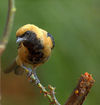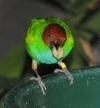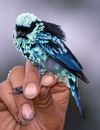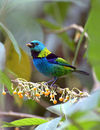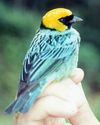Genus Tangara

Golden Tanager - Its plumage is overall golden-yellow with black to the back, wings, tail and ear-coverts. Some subspecies are partially/largely brown below.
Azure-rumped Tanager - Its plumage is mostly very pale blue, though it has a periwinkle crown. It also has a black mask around its lores. The bill is gray with a dark tip. The mantle is mottled green and black. The wings and tail are black with blue edgings. This bird makes a wi sseeu song and a sii call.
Opal-crowned Tanager - It is found in the eastern Andes drainages to the western Amazon Basin in southern Colombia, eastern Ecuador and Peru and a region of northwestern Bolivia; for Brazil in southwestern-western Amazonas state and Acre.
Burnished-buff Tanager - It is found in the northern Guianas, most of Venezuela and east-central Colombia; also near the Amazon River outlet in Brazil, as well as most of the east of that country, Paraguay and northeast Argentina. It also occurs very locally in Bolivia and Peru. It can be seen in virtually any semi-open habitat with trees, including human-altered habitats such as gardens, plantations and parks.
Paradise Tanager - Found in humid tropical and subtropical forests in the western and northern Amazon Basin in South America, it occurring in Venezuela, Peru, Colombia, Ecuador, Bolivia, Brazil and the Guianas. Despite its scientific name, it is not found in Chile.
Golden-eared Tanager - The Golden-eared Tanager is a species of bird in the Thraupidae family . It is found in Bolivia, Colombia, Ecuador, and Peru. Its natural habitat is subtropical or tropical moist montanes.
Red-necked Tanager - It is found in Argentina, Brazil, and Paraguay. Its natural habitats are subtropical or tropical moist lowland forests and heavily degraded former forest.
Blue-browed Tanager - The Blue-browed Tanager is a species of bird in the Thraupidae family. It is found in Bolivia, Colombia, Ecuador, and Peru. Its natural habitat is subtropical or tropical moist montanes.
Gilt-edged Tanager - Its natural habitats are subtropical or tropical moist lowland forests, subtropical or tropical moist montanes, and heavily degraded former forest.
Brassy-breasted Tanager - Its natural habitat is subtropical or tropical moist montane forests.
Spangle-cheeked Tanager - It is common from about 1200 m to 3000 m altitude in the canopy of epiphyte laden wet mountain forests, and at lower levels in semi-open areas like clearings with trees, second growth and woodland edges. The bulky cup nest, lined with bromeliad leaves, is built in a tree fork or on a branch high amongst the epiphytes. The normal clutch is two eggs.
Seven-coloured Tanager - Its natural habitat is subtropical or tropical moist lowland forests. It is threatened by habitat loss.
Emerald Tanager - The Emerald Tanager is a species of bird in the Thraupidae family. It is found in Colombia, Costa Rica, Ecuador, and Panama. Its natural habitats are subtropical or tropical moist lowland forests and subtropical or tropical moist montanes.
Speckled Tanager - It is probably a close relative of the Spotted Tanager which replaces it to the south. These two species are generally presumably to be fully allopatric, but may actually be parapatric: in 1998 a Speckled Tanager was found in the Serranía de los Churumbelos , just about 100 miles north of where Spotted Tanagers are known to occur.
Bay-headed Tanager - It occurs in forests, particularly in wetter areas. The bulky cup nest is built in a tree and the normal clutch is two brown-blotched white eggs. The female incubates the eggs for 13–14 days to hatching, with another 15–16 days before the chicks fledge .
Silver-throated Tanager - It is common from about 600 m to 1700 m altitude in the lower and middle levels of wet mountain forests and adjacent semi-open areas like clearings with shade trees, second growth and woodland edges. In the heavy rains of the wet season, it will descend to sea level. The compact cup nest is built 1–13 m high in a tree on a branch. The normal clutch is two brown-blotched off-white eggs. This species will raise two broods in a season
Plain-coloured Tanager - The Plain-coloured Tanager is a species of bird in the Thraupidae family. It is found in Colombia, Costa Rica, and Panama. Its natural habitats are subtropical or tropical moist lowland forests and heavily degraded former forest.
Metallic-green Tanager - It is found in Colombia, Ecuador, and Peru. Its natural habitat is subtropical or tropical moist montane forests.
Golden-hooded Tanager - Adult Golden-hooded Tanagers are 13 cm long and weigh 19 g. The adult male has a golden head with a black eyemask edged with violet blue above and below. The upperparts of the body are black apart from the turquoise shoulders, rump and edgings of the wings and tail. The flanks are blue and the central belly is white. Females have a greenish tinge to the head, sometimes with black speckling on the crown, and more extensively white underparts. Immatures are duller, with a green head, dark grey upperparts, off-white underparts, and little blue in the plumage.
Turquoise Tanager - It occurs in forest, woodland and cultivation. The bulky cup nest is built in a tree or shrub, and the female incubates three brown-blotched grey-green eggs.
Masked Tanager - Its natural habitats are subtropical or tropical moist lowland forests and heavily degraded former forest.
Beryl-spangled Tanager - Its range is from Venezuela to Bolivia. Its nest is a mossy cup in a tree fork; in Ecuador west slope, eggs in early March.
Gray-and-gold Tanager - The Grey-and-gold Tanager is a species of bird in the Thraupidae family. It is found in Colombia, Ecuador, and Panama. Its natural habitats are subtropical or tropical moist lowland forests and subtropical or tropical moist montanes.
Black-backed Tanager - Its natural habitats are subtropical or tropical dry forests and subtropical or tropical dry shrubland. It is threatened by habitat loss.
Sira Tanager - Its natural habitat is subtropical or tropical moist montanes. It is threatened by habitat loss.
Chestnut-backed Tanager - It is found in Argentina, Brazil, Paraguay, and Uruguay.
Golden-naped Tanager - The Golden-naped Tanager is a species of bird in the Thraupidae family. It is found in Bolivia, Colombia, Ecuador, and Peru. Its natural habitats are subtropical or tropical moist montane forests and heavily degraded former forest.
Rufous-throated Tanager - Its natural habitats are subtropical or tropical moist montanes and heavily degraded former forest.
Green-and-gold Tanager - It is found in the western and central Amazon Basin in eastern Venezuela, Colombia, Ecuador, Peru, central Bolivia, and northwestern Brazil. Its natural habitats are subtropical or tropical moist lowland forests and subtropical or tropical swamps.
Green-headed Tanager - As other members of the genus Tangara, it is a small colorful bird, measuring an average of 13.5 centimeters . While essentially a bird of humid forests, it is also common in orchards and parks, where it moves through the canopy, making itself inconspicuous, as its apparently flashy blue-green coloration camouflages it well amongst the foliage.
Dotted Tanager - It is found in Brazil, French Guiana, Suriname, and Venezuela. Its natural habitats are subtropical or tropical moist lowland forests and heavily degraded former forest.
Blue-and-black Tanager - It is found in Bolivia, Colombia, Ecuador, Peru, and Venezuela. Its natural habitats are subtropical or tropical moist montane forests and heavily degraded former forest.
Scrub Tanager - It is found in Colombia and Ecuador. Its natural habitats are subtropical or tropical moist montane forests, subtropical or tropical high-altitude shrubland, and heavily degraded former forest.
Yellow-bellied Tanager - It is found in Bolivia, Brazil, Colombia, Ecuador, Guyana, Peru, and Venezuela.


